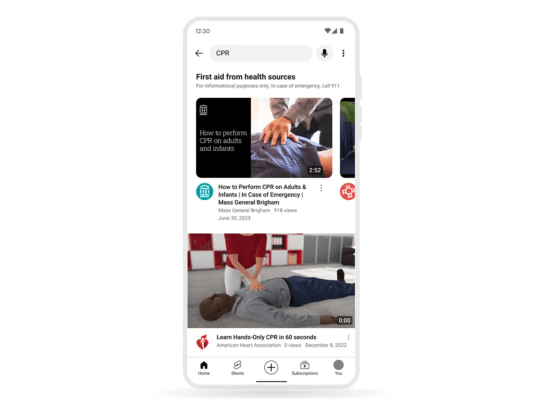YouTube announced today that it’s making it easier to find accurate life-saving information about basic first aid and emergency care with the launch of its new First Aid Information Shelves. The new shelves will be pinned to the top of search results and will feature videos from credible health organizations like Mass General Brigham. The videos are designed to be easy-to-follow, with the aim of helping people quickly get access to actionable first aid information without having to read or listen to complex instructions.
The shelves will appear when you search for a variety of acute health topics, including CPR, choking/Heimlich, bleeding, heart attack, stroke, seizure and opioid overdose. For instance, the shelf will display videos on how to perform CPR, how to stop bleeding and how to help someone who is overdosing.
The new initiative is launching in the United States in English and Spanish, with additional languages and countries to come.
“Today’s announcement is a significant step forward to increase access to authoritative resources on first aid care, especially for those without medical training at times when they may need it most,” said Dr. Garth Graham, YouTube’s director and global head of healthcare and public health partnerships, in the blog post. “We’re committed to harnessing the power of video to make public health information truly public.”
The new video shelves are YouTube’s latest effort toward fighting medical misinformation on its platform.
Medical misinformation became a significant problem on YouTube during the COVID-19 pandemic, which led the Google-owned platform to ban videos with vaccine misinformation. This included content that spread misinformation about vaccine safety, the efficacy of vaccines and ingredients in vaccines. Before announcing the change, YouTube had already banned more than 1 million videos spreading dangerous COVID-19 misinformation.
Vaccine misinformation isn’t the only medical misinformation category that YouTube has been fighting against. Last summer, YouTube announced that it was removing videos that promoted “harmful or ineffective” cancer treatments or discourages viewers from getting professional medical treatment, and in 2022, YouTube said it would start cracking down on videos containing abortion misinformation and take down videos deemed unsafe.
